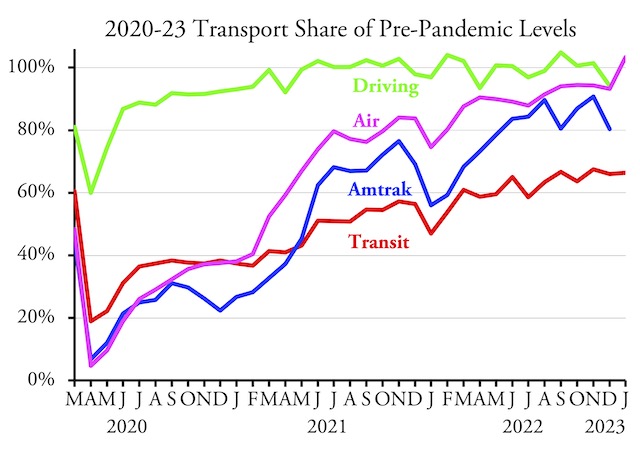Transit carried 66.4 percent as many riders in January 2023 as January 2019, according to data released by the Federal Transit Administration earlier this week. Though this is a slight improvement from the 66.0 percent of December 2022, the total number of January riders was lower than December’s. This is unusual: normally, January sees more riders than December. January 2023 had one fewer working day than January 2019, which may have contributed to the decline in ridership from December.
Transit ridership has hovered around 66 percent of pre-pandemic (2019) numbers for the last five months, suggesting it may not grow much further. Early in the pandemic, I predicted that ridership would never recover to more than 75 percent of pre-pandemic levels, which I later revised downwards to 70 percent (a projection supported by McKinsey). That’s looking to be slightly too high.
The number of air travelers, by comparison, exceeded 100 percent of pre-pandemic numbers for the first time in January, according to the Transportation Security Administration. Domestic air travel reached 100 percent in September, while domestic and international travel together were 103.3 percent in January. Amtrak hasn’t published its January performance report yet, and the Federal Highway Administration didn’t get its December report out until March 1 so we may have to wait three more weeks for the January report.
Transit systems that are doing particularly poorly include those in the Chicago (54.4%), Philadelphia (58.3%), Atlanta (53.3%), Detroit (51.3%), Phoenix (44.6%), San Francisco-Oakland (50.2%), Minneapolis-St. Paul (53.9%), St. Louis (56.6%), and Portland (57.5%) urban areas. The downtowns of many of these areas are among the slowest to recover. Some of these numbers must be used with caution: the data say that Cincinnati transit carried only 19 percent of pre-pandemic numbers, but that’s because Cincinnati’s largest transit agency failed to report ridership for January 2023. That should be corrected next month.
As usual, you can download my enhanced version of the Federal Transit Administration’s spreadsheet (19.7 MB). The FTA raw data showing monthly ridership from January 2002 through January 2023 are in cells A1 through JB2245. Annual totals are in columns JC through JX. Mode totals are in rows 2248 through 2268. Agency totals are in 2275 through 3274. Urban area totals are in rows 3280 through 3570.
Column JZ shows January 2023 ridership as a percent of January 2019. Column KA shows January 2023 as a percent of January 2022. Column KB shows 2022 ridership as a percent of 2019; this was also on the December spreadsheet, but the FTA may have updated some numbers since then. These enhancements are made on both the ridership (UPT) and service (VRM) worksheets, showing that agencies operated 84.2 percent as many vehicle-revenue miles of service in January even though nationwide ridership is only 66.4 percent.









I work in downtown Oakland California and generally take BART to work. I am only required to report to the office twice a week so I don’t use BART as much as I used to. When I do use BART is is impossible not to notice that since Covid-19 BART operations have degraded severely. Prior to Covid, the trains generally operated on time. Presently, the trains seem to arrive pretty much at random. Of course their ticket revenues are way down but I believe they are still operating off of generous federal subsidies so I am not sure what is causing this. In any case their poor operations certainly hurt their efforts regain ridership. This task is difficult enough in any case but BART’s poor operations only make matters worse.
https://slate.com/business/2021/09/paris-cars-bicycles-walking-david-belliard-anne-hidalgo.html
Mayor Anne Hidalgo has opened linear parks in the old highways along the Seine, phased out diesel cars in the city, opened bus lanes, raised parking meter prices, and plowed bike lanes down hundreds of streets.
Plans are in the works to pedestrianize the Champs-Elysées and plant thousands of trees to green, clean, and cool the city.
.. latest projects include establishing car-free zones outside schools and enforcing the capital’s new speed limit of 30 kilometers per hour—a notch below 20 mph.
This will be interesting to watch over the next few years. Real live people will “vote with their feet” or “vote with their cars” to stay or leave and the city of Paris will live with the result.
New York City famously houses many car-free people and families who are apparently happy with their situation. But New York City houses only a small fraction of the US population and the trend over my lifetime has been from big cities to suburbs and smaller cities/towns.
rovingbroker, yep, it will be interesting to see what happens. From what I’ve heard, less and less people are living in Paris due to it being too crowded.
And that makes perfect sense: the more densely populated a place becomes, the less people live there because it’s too crowded.
Your comment contradicts itself. If a place becomes more densely populated by definition more people are living there than before.
And it makes perfect sense that more people will flee Paris when battery buses catch on fire.